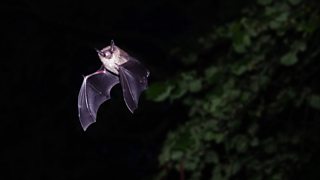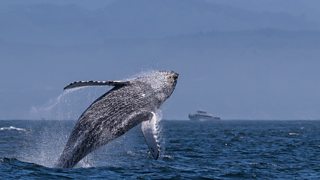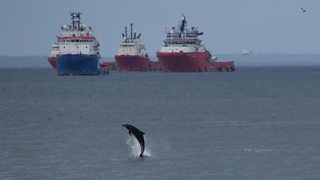Dr Nathan Merchant. Principal Scientist at the Centre for Environment, Fisheries and Aquaculture Science
Seen but not heard
I step into the garden and the sounds of spring are all around. Birds chirp and twitter, bees buzz, new leaves rustle in the breeze. It’s a joyous time of year for the ear, and one we have long celebrated. In fact, one of the oldest known songs in English – Sumer is icumen in (circa 1260) – rejoices in the sounds of summer approaching: the cuckoo singing, the ewe bleating, the goat… farting.
But there are also sounds we cannot hear. As day turns to dusk, the silhouettes of bats whirl and flit silently against the fading sky. Even in complete darkness, bats can navigate and hunt. This puzzled Lazarro Spallanzani, an 18th century biologist. How could the unfortunate bat whose eyes he removed still manage to avoid obstacles? Spallanzani hypothesised some undiscovered “sixth sense,” but it was not until 1938 that two biologists using specialist recording equipment observed that bats use sound to echolocate, at frequencies that are too high-pitched for us to hear.

Common pipistrelle by Robin Bennett on Flickr
In the ocean, too, our limited hearing masks a multitude of unheard wonders. In 1956, Jacques Cousteau chose to name his Oscar-winning underwater documentary The Silent World. In fairness to Jacques, it does usually seem pretty quiet down there: human ears are poorly adapted to hear underwater. But if we listen instead through hydrophones (underwater microphones), we discover that the ocean has some of the richest and strangest soundscapes on Earth.
A whale of a record
The tide began to turn on our appreciation of subsea sounds in 1970, when a bioacoustician named Roger Payne scored an unexpected smash hit with Songs of the Humpback Whale. Using hydrophones, Payne had recorded an album of humpback whale song which introduced the world to those now familiar plaintive moans that echo hauntingly through the blue.

Humpback whale by Craig Richardson on Flickr
Since then, the study of whale calls has led to key breakthroughs in our understanding of the intelligence and social complexity of nonhuman animals. For example, building on Payne’s work, we now know that humpback whales have smash hits of their own. In eastern Australia there is a trend-setting population of whales that introduces a new song every year or two, and the new number then spreads gradually to other populations in the South Pacific and as far east as French Polynesia. Observations like these demonstrate that whale societies have socially transmitted behaviours that are consistent with what we might call ‘culture’.
And it is not only whales and other marine mammals that use sound in the ocean. Just like birds in a forest, fish make a diverse range of calls which reach a crescendo at dawn and dusk. This choral ensemble of fish and marine mammals is joined by a percussion section of marine invertebrates: sea urchins scratch and crackle as they scrape the algae from rocks, and one of the loudest biological sounds is made by the snapping shrimp – aka the pistol shrimp – whose oversized claw snaps shut so hard that it turns seawater into a bubble of steam.
A noise that annoys
Back in my garden, the calming birdsong is not the only sound of spring. Next door, workmen hammer away at renovations and crank up the radio. There is an ever-present rumble of traffic. Aeroplanes pass overhead. This growing presence of anthropogenic (manmade) noise has numerous detrimental effects on human health; some studies put noise pollution second only to air quality as a public health concern. Nonhuman animals are not immune to our noise either, and impacts have been recorded in birds, reptiles, amphibians, insects and mammals. But what about underwater?
Unlike in air, sound can travel for thousands of kilometres underwater. This has enabled baleen whales such as the blue whale to evolve long-range communication using low-frequency calls, which can travel across entire oceans. But manmade noise can travel just as far. Since the invention of propeller-driven ships in the nineteenth century, we have added to this noise with sonar systems, seismic airgun surveys and offshore construction.

Aberdeen dolphins by Walter Innes on Flickr
If you’ve ever had the experience of shouting into someone’s ear to be heard at a nightclub, spare a thought for the blue whale, whose communication range is estimated to have reduced tenfold since 1940. Marine life may leave or avoid noisy areas, experience physiological stress, and in some cases suffer hearing damage or death from noise exposure. These days, our subsea playlist of industrial techno is drowning out the symphony of biological sound that has evolved over millions of years without us.
Silent spring?
In 1962, Rachel Carson published Silent Spring, the book that helped to kick-start the environmental movement in the United States. The title refers to the widespread use of pesticides and their role in reducing bird populations, but it could equally apply to the spring of 2020, which has been eerily quiet for other reasons.
The global reductions in flights, shipping, and road traffic brought about by COVID-19 have almost certainly lowered noise levels significantly. One study from Canada has already shown a reduction in underwater noise since the lockdown there began. More broadly, the pandemic creates an unplanned experiment that may help us to understand how wildlife might benefit if we dialled down the volume on noise pollution.
The good news is that it would not take a permanent pandemic to make quieter oceans a reality. Technological solutions are already available, from quieter ships and seismic surveys to bubble curtains that dampen noise pollution from offshore construction. But these technologies come at a cost. The question for us as a society is how much we value the benefit this would bring to the marine organisms whose planet we share.
